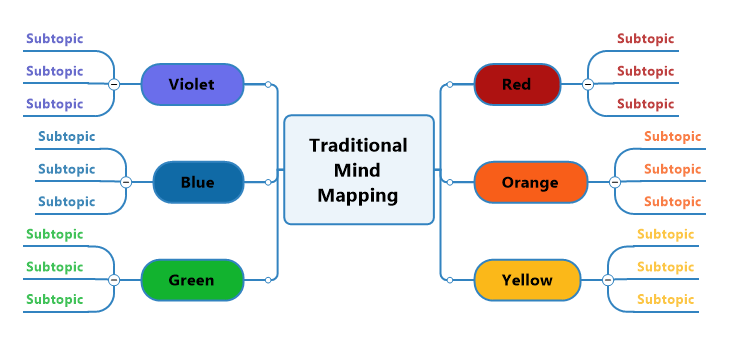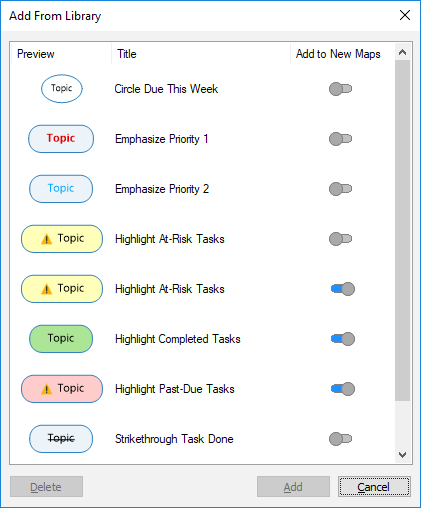Interactieve diagrammen zijn een heleboel slimmer met MindManager
We’re thrilled to announce that the SmartRules™ feature has been named the 2018 Mind Mapping Software Innovation of the Year by The Mind Mapping Software Blog!
MindManager isn’t about drawing pictures or simply making diagrams. It isn’t a passive application that’s only meant to visually represent an idea or process. MindManager creates living interactive diagrams that illustrate status, progress, and a variety of other states to accurately represent not just a point in time, but across time as change happens.
In MindManager 2019, we’ve added a powerful new capability called SmartRules™ which transforms and embeds intelligence into your diagrams.
What are SmartRules?
You define and embed SmartRules in your diagrams to perform an action based on a preset criterion. SmartRules can apply to either all topics or specific ones.
When a topic is created, edited, or moved, the diagram’s SmartRules triggers are evaluated and when the triggering criterion are met, the rule’s effects are applied.
SmartRules Triggers
Rules can have one or more triggers which can be either:
- Data or content within a topic; or
- The topic’s location within a diagram.
For instance, you can create a trigger based on the topic’s text or task information, which can include whether or not the task is at-risk, the due date or start date, the duration or effort values, assigned resources, task progress, priority or whether it’s a milestone or not. Or, any icon or tag assigned to a topic can be a trigger.
Other powerful triggers can be whether or not the topic belongs to a specific branch or if it is within the boundaries of a background object (i.e. trigger the SmartRule when the topic appears in a specific section of a Venn diagram or Matrix).
SmartRules triggers for MindManager 2019 include:
- Topic text (i.e. if the topic contains specific words or characters)
- Topic icons and tags
- Number of attachments, links or subtopics
- Topic properties
- Task duration, effort, priority, progress, resource, milestone, start date or due date
- Task is at-risk (of being late)
- Belongs to a task info roll-up branch
- Topic belongs to a specified branch or exists within an object within the diagram
SmartRules Effects
Rules can also have one or more effects. Effects can change both the topic’s appearance as well as data within the topic itself.
From a conditional formatting perspective, the topic effects can change:
- Topic shape, style, fill or line colours
- Font’s styles like bold, italic, strikethrough or underline
- Font size or font colour
From a data perspective, the following can be added or adjusted on a topic:
- Topic icons or tags
- Topic properties
- Task resources, priority or progress
Why we built SmartRules
We’re looking to help users save time and apply consistent processes within their diagram or across multiple diagrams. Our goal is to put more power and control at your fingertips to build intelligence into your diagrams so that information is represented the way you want to see it with less effort on your part.
There were a few use cases that I originally had in mind when we discussed this feature. Here are a couple of examples:
1. I wanted to have a branch for tasks in a meeting map but I found it cumbersome to add the progress indicator to every new topic in the branch. So, we enabled the rules to apply a 0% progress indicator to any new topic added to the task branch and allowed overrides so the user could mark the task complete with a click. This rule saves time by not having to go to the ribbon menu, switch menu to the home or task menus, find the progress icon, select the progress icon and then return to the map … every time a new task is added.

2. Change the status of a topic as it moves from one branch to another. An example could be managing tasks in a Kanban process where you have topics change progress and even appearance from one branch to the next.
In the example below, as soon as you drag a feature from the release backlog into the sprint backlog, the progress indicator is added. When a feature is started (and dragged into the in process branch), the progress advances automatically. And finally, when you drag the feature into the completed branch, the topic is marked complete, the fill colour changes to green and the text is bolded. All of the changes to progress and appearance adjust as soon as you drag or add topics into the respective branches. Automatically. Set it up once and run entire workflows using MindManager!

3. A final example would be to create a more traditional mind map where you can set the colours / formatting for descendants of each main branch. MindManager normally defines look and feel based on the level of the topic from the central topic (e.g. main topics, their children, their children’s children, etc…). In the example below, each branch can have its own look and feel.

When should you use it?
If you’re repeatedly applying similar changes to topics within your diagrams, you may want to evaluate adding a SmartRule to automate these changes for you.
We’ve also implemented another powerful time saving feature. You can save any of your rules into a rules library. And, you can set any of the rules in the library to apply to any new map you create. So, if you want to implement standards across all of your maps (like how a task should appear when it is marked complete), you now can create the rule and have it apply to every new map you create moving forward.

When should you use it?
If you’re repeatedly applying similar changes to topics within your diagrams, you may want to evaluate adding a SmartRule to automate these changes for you.
We’ve also implemented another powerful time saving feature. You can save any of your rules into a rules library. And, you can set any of the rules in the library to apply to any new map you create. So, if you want to implement standards across all of your maps (like how a task should appear when it is marked complete), you now can create the rule and have it apply to every new map you create moving forward.
Where can you find the SmartRules?
You can find the SmartRules feature in the Advanced menu.

Through the menu for SmartRules, you can also view the Rules Library where you can set rules to be applied to all new diagrams.
How will you use SmartRules to accelerate your processes and visualize success?
Let us know any questions you have and how you’re starting to use this powerful new capability to drive consistency across your processes and increase your productivity.
